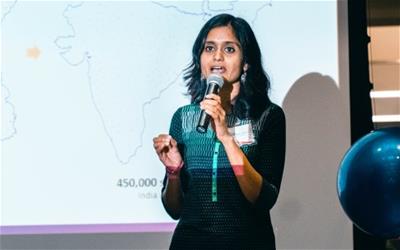Feb 1, 2022
Gies research partnership uplifts education of teenage girls in India
What began as a chance meeting at a Gies College of Business-led conference in Tanzania has evolved into a research partnership that is examining the democratization of education for teenage girls in rural India during the pandemic.
Gies professor Aravinda Garimella is working with doctoral candidate Ananya Tiwari, whose non-profit SwaTaleem works with government-run residential girls secondary schools (KGBVs) that are designed to improve literacy in India and keep girls from dropping out of school.
 An assistant professor in Gies’ Department of Business Administration, Garimella (right) studies information technologies and how they can improve business and society at large. Tiwari is a PhD student in educational psychology at the University of Illinois. SwaTaleem received support and funding through the university’s iVenture Accelerator program – which is housed at Gies College Business – and received funding from the Google Impact Challenge in 2021.
An assistant professor in Gies’ Department of Business Administration, Garimella (right) studies information technologies and how they can improve business and society at large. Tiwari is a PhD student in educational psychology at the University of Illinois. SwaTaleem received support and funding through the university’s iVenture Accelerator program – which is housed at Gies College Business – and received funding from the Google Impact Challenge in 2021.
The research setting is the Mewat district in Haryana, India, where the female literacy rate is 32% and an average family size is 12 members.
“Although it is only 90 minutes away from Delhi, the development metrics and sociocultural norms show it is ages behind. We thought if we could do something in Mewat, then perhaps we could make it work in other places as well,” said Tiwari. “We are taking a systems approach so that we can ultimately work with multiple schools at scale.”
The pandemic has had a devastating effect on this already challenging learning environment. When COVID-19 hit, the schools shut down and there was no plan in place for educational continuity.
 “When the KGVB schools shut down, some families began marrying off girls as soon as they came home. There was no communication or engagement from the schools to the parents. We knew we had to provide a link,” said Tiwari (left). “Buy-in from the parents and teachers was very important. We looked at all of the stakeholders’ strengths, weaknesses, opportunities and constraints.”
“When the KGVB schools shut down, some families began marrying off girls as soon as they came home. There was no communication or engagement from the schools to the parents. We knew we had to provide a link,” said Tiwari (left). “Buy-in from the parents and teachers was very important. We looked at all of the stakeholders’ strengths, weaknesses, opportunities and constraints.”
Because these communities don’t have access to the internet, the solution couldn’t rely on smart phones. To teach reading comprehension, math, science and financial awareness, lessons are told through audio stories that feature young Indian women like themselves. They drive engagement with the students by breaking down stereotypes and exploring expanded career opportunities. For delivery and comprehension assessment, they use an interactive voice response system much like those used in customer service models.
Most households, however, have only one basic mobile phone held by a male family member who likely works as a daily wage laborer in agricultural fields. So SwaTaleem researched when to time the calls so that girls would have access to phones.
As Habiba, a ninth-grade student explained: “I wait for 7 pm because I know that is when I get the call with the stories. I look forward to the call. Sometimes, we put the phone on speaker and mother also sits with me and we listen to the stories together.”
This project is an example of immediately identifying interventions to address a problem in the field and disseminating learnings from this action to benefit broader social science research.
“Technology solutions should be embedded in social justice. Social justice should not come once the technology has been implemented, but in the initiation stage,” said Tiwari, who studied chemistry, neuroscience and liberal arts before switching to education at the University of Illinois. She is a recipient of the Illinois Innovation Prize and the Illinois International Achievement Award.
“There’s a misperception that innovation is simply using the most cutting-edge technology,” said Garimella, a former consultant at Ernst & Young and British Telecommunications who joined Gies College of Business in 2018. “Innovation comes in many shapes and sizes, and in this context the technology doesn’t get any more basic. The innovation here is identifying that this technology is the best fit for this environment and ensuring that design and implementation strategies account for sociocultural factors.”
“This is an excellent illustration of how technology can be effectively designed, used, and implemented to uplift vulnerable sections of society,” Garimella added. “By analyzing the process here, we can give actionable insights to IT managers who are planning to implement interventions in resource-constrained environments with underlying structural inequalities.”
Added Tiwari, “We are at a very exciting point of democratizing education, and I see a lot of promise. The pandemic came with a lot of heartbreaking losses but if there’s one silver lining, it is that we learned how to accommodate people with different needs.”


